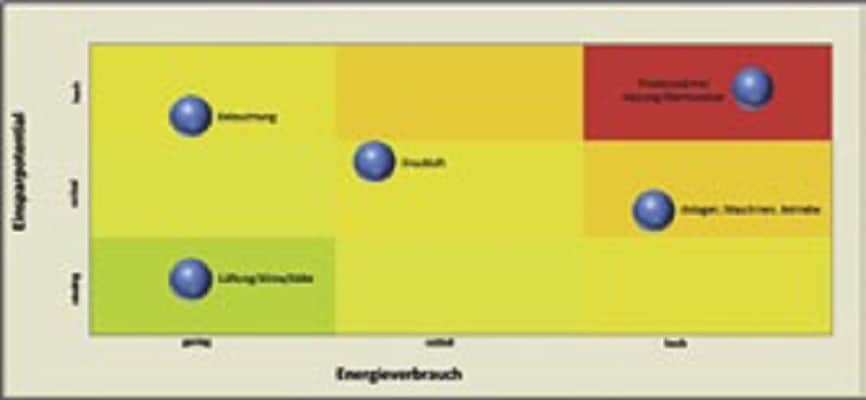DIN EN ISO 50001
The introduction of an energy management system in accordance with DIN EN ISO 50001 is the focus of many companies' energy policy plans due to rising energy prices and tax relief options. What experiences have been made with the practical implementation of the standard requirements? Where do the solutions lie?

E nergy management systems (Figure 1) have proven themselves in practice as an excellent tool for the systematic optimization of a company's energy-related performance. They thus make an important contribution to reducing energy costs and strengthen sustainable corporate development.
Against the background of the theoretical standard specifications, different approaches to interpretation emerged in the implementation in operational practice.
Energy planning
The basis for setting up an energy management system is the systematic recording and analysis of energy flows. When recording data, inadequate recording structures of the existing measuring systems often cause problems, as accompanying estimates, high
ISO 50001 strengthens sustainability
extrapolations and punctual measurements often do not achieve the necessary data depth for reliable and detailed conclusions within the framework of the energy evaluation. Supplementary measuring equipment requires additional time and costs, but depending on the measuring point structure, is often indispensable for a well-founded data analysis with regard to the derivation of significant savings potentials.
The energy assessment uses energy input, energy consumption and the corresponding energy savings potential, which reflects the optimised energy use of the plant and equipment. Quantitative or measurable criteria should be used as far as possible. A well-founded and meaningful assessment may require additional measurements.
The results of the energetic evaluation and the determined
Savings are the basis for energy targets
Energy saving potentials are prioritized. In practice, prioritization often only takes into account the influencing variable of energy consumption. This consideration is too imprecise and assumes that a high energy consumption necessarily also has a high savings potential.
This correlation cannot be derived in general terms and requires a more differentiated approach (Figure 2). As a result of this analysis, the focus of the areas with relevant savings potential becomes clear. Quantitative operational energy targets are derived from the prioritization of savings potentials, which are documented in the action plan.
Baseline not set in stone
When quantifying the energy targets, energy performance indicators (EnPIs) are defined that are aligned with the energy baseline. The energy baseline is not to be understood as a fundamentally fixed value, but is to be reviewed again if necessary, especially after significant changes to the plant, and adjusted if necessary. Our experience shows that, depending on the respective organisational structure of the energy distribution, several baselines in connection with key figures to be defined can prove to be useful at the same time.
As a rule, EnPIs should be defined as relative indicators to ensure the greatest possible comparability of energy-related performance (e.g. kWh/unit of production).
Particular challenges in the definition of EnPIs arose above all in the case of companies that were unable to determine a meaningful energy baseline due to insufficient data, and in the case of companies that were unable to derive a clear production reference for the energy-relevant variables due to their corporate structure.
Further uncertainties arise in the case of changing effects that cannot be influenced, such as the influence of the weather. In practice, it became apparent that these external influences, depending on the target definition, did not always allow a clear statement on the degree of implementation of the defined targets, even when taking into account auxiliary data (such as heating degree days) to correct for changing weather conditions.
Legal compliance
Analogous to existing environmental and occupational health and safety management systems, ISO 50001 requires an identification of relevant legal and other relevant requirements and an assessment of compliance with these requirements.
For existing environmental and occupational health and safety management systems, the additional effort required for a system expansion is comparatively low. The existing structures, processes and tools (online databases, legal directories, etc.) can be used in full. Only the energy law regulations need to be supplemented.
Introduction and implementation
Both integrated and stand-alone energy management manuals are common among companies. Both va
Integration possible without problems
variants have proven their worth. Since the structure of ISO 50001 is also essentially based on the main elements of ISO 14001 and ISO 9001, integration into an environmental management system in particular is possible without any problems. The main arguments in favour of integration are practicability, the use of synergies and improved acceptance within the company.
In addition to the processes already in place in existing quality and environmental management systems, the following specific procedures in particular are required:
- Energy planning (including energy assessment, baselines, action plans, etc.)
- Energy controlling
- Procurement of energy-related equipment, products, facilities and energy services
- Procurement of energy
In addition, there is a need to supplement other processes implemented in existing management systems with regard to the implementation of the requirements of ISO 50001.
Broadly supported
For the maintenance, implementation and monitoring of the energy management system, the appointment of one or more management representatives is required. In larger and complex companies, in addition to the energy management officer (management representative), further energy officers are often appointed at departmental level, who support the energy management officer as part of an energy management team within the framework of defined areas of responsibility.
In particular, representatives from the areas of production and maintenance/facility management have proven themselves as members of the mandatory energy management team. Representatives from the areas of procurement, development and logistics should also be considered in the extended circle of the energy management team.
Internal communication is an important pillar
The ISO 50001 provides information about the instruction of external companies within the scope of their energy-relevant
Include procurement, development, logistics
activities at the site, there are no further additional requirements for external communication. Nevertheless, experience from certification practice shows that for certain sectors (e.g. measurement and control technology) the introduction of an energy management system in accordance with ISO 50001 and a corresponding external presentation certainly represent a decisive contribution and thus an added value within the framework of image cultivation and marketing of the company.
In addition to technical energy efficiency measures, internal communication, in particular on the responsible use of energy, is another important pillar for the implementation of a sustainable energy management system, which must be supported by all employees of a company. A frequently careless handling of energy is rightly complained about by many companies and it should be contributed to a reduction of energy consumption in the company through appropriate training and awareness raising. The requirement of ISO 50001 for the introduction of a process for improvement measures combined audit measures for the energy management system is intended to support the commitment of employees to energy saving. Experience gained during the first certification cycle has already shown the first positive developments.
Combined audits make sense
When carrying out integrated internal and external system audits, combined audits in accordance with ISO 14001 and ISO 50001 have proven most effective due to the far-reaching synergies. An additional integration of a QM audit according to ISO 9001 is possible in principle, but in practice requires an increased organizational and coordination effort to cover all required standard elements.
Conclusion
In a large number of companies that have introduced an energy management system in accordance with DIN EN ISO 50001, significant improvements in energy-related performance and thus cost savings could be achieved after only a short time. The obligatory involvement of top management ensures the sustainable promotion of efficient energy use in the company. Also not to be underestimated are the increase in the company's image and the raising of employee awareness of the responsible use of resources. ISO 50001 should not only be regarded as an abstract set of rules for setting up an energy management system, but should also be interpreted and used as an effective instrument for sustainably increasing energy efficiency in the company.









